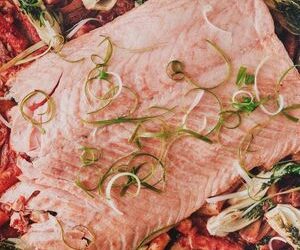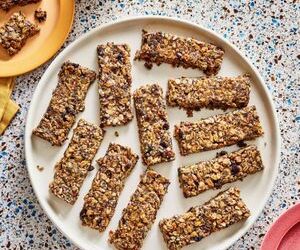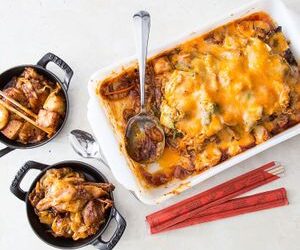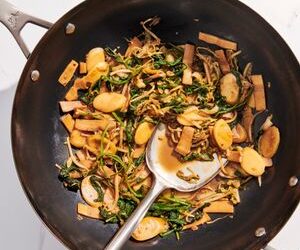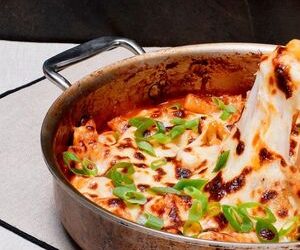Pungent. Spicy. Savory. Sweet. Tteokbokki is saucy, delicious comfort food in a bowl: captivating to the eye and pleasantly explosive to the taste, it will make you break into a happy sweat. The tender chewiness of Korean rice cakes is enticingly satisfying, the chili’s heat is disorienting and addictive: you fall in love faster than your brain can process. Add in some crunchy green onions and savory fishcakes and you’ve got yourself quite a meal.
There are many variations of tteokbokki, which translates to “stir-fried rice cakes”: Gungjung-tteok-bokki is a Joseon-era royal court version that uses beef, various vegetables, and a soy sauce base; ra-bokki is served with the addition of instant ramen noodles in a soupier base. Our recipe here is for a gochujang-based tteokbokki, a red-hot, sweet-and-spicy version often served as a street snack and bar food. Here are some tips for making this dish at home.
Homemade anchovy broth
A staple of Korean cooking, dried anchovies add a crucial umami savoriness that forms the flavor bedrock of tteokbokki. This recipe uses a homemade broth that marries toasted dried anchovies with salty dried kelp and sweet, earthy dried shiitake mushrooms to provide a gentle seafood flavor. If dried anchovies and kelp can’t be found at your local stores, there are dashi packets available online that would be a good substitute. In a pinch, you can skip the homemade broth and substitute in vegetable or chicken broth, or water.
Spice level
There are two sources of heat in this dish: gochujang, Korean red chili pepper paste, and gochugaru, Korean red chili pepper flakes. Gochujang is sweet, salty, and spicy, with an aromatic fermented glutinous rice note. Gochugaru is halfway between your standard crushed red pepper flakes and Aleppo pepper: beyond just being spicy, it is also fragrantly smoky and sweet, with a smell reminiscent of a freshly cut green bell pepper. Feel free to decrease or increase the amounts of spicy ingredients depending on your personal taste.
A touch of sweetness and tang
To balance out the spice and make the sauce extra glossy, we’re adding a tablespoon of honey. Any type of sugar will work here: granulated, brown, corn syrup, brown rice syrup—so use whatever you like or have on hand! Be sure to add in a couple teaspoons of vinegar to brighten up the mix with a savory, ketchup-esque kick.
Additions
We’re using fish cakes in our tteokbokki but you can really go any direction you want at home with additional ingredients to bulk up the dish: personalize it with cabbage, a brick of instant ramen, boiled eggs, or add in the mushrooms, kelp, and anchovies leftover from making the broth for zero-waste cooking!
Reheating leftovers
If served as a main, this recipe will feed two very hungry souls or three less voracious eaters. If serving only as a side dish or a snack, leftovers will store well in an air-tight container in the fridge for 4 to 5 days. When reheating, stir in water or broth as needed to reach desired sauce consistency: this can be done in the microwave or on the stovetop.
If you’ve made this recipe, we’d love to hear how you liked it! Be sure to leave us a note and a rating down below.
This content is imported from {embed-name}. You may be able to find the same content in another format, or you may be able to find more information, at their web site.
This content is created and maintained by a third party, and imported onto this page to help users provide their email addresses. You may be able to find more information about this and similar content at piano.io


